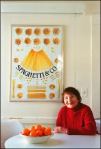Posts Tagged ‘women’
Cooking in Ten Minutes by Edouard de Pomaine.
“Do not imagine that ten-minute cooking is going to condemn you to an eternal round of beef-steak without any of the frills of finer cookery.
Your gas stove has two burners, if not three. What is to prevent you cooking slices of ox kidney saute’ in butter on the one, while you make a sauce bearnaise on the other?
During the same ten minutes you can prepare both the kidneys and the sauce. The result is delicious. I have done it time and again. Thanks to the sauce the ordinary ox kidneys, despised by the fastidious, assume an aristocratic manner.
You can always prepare meat and a sauce, but are there many rapidly prepared sauces? That all depends on the liveliness of your imagination. Invent the sauces. The great thing is to prepare them quickly, and for this you must follow the advice which I shall give you for the preparation of some standard sauces.”
~~~~~
Here’s what Elizabeth David wrote about Pomaine in her book An Omelette and a Glass of Wine. [pp. 175-182]
“In the days when Pomaine was writing, chefs did not dream of braising vegetables – lettuces, leeks, Belgian endives, for example – without a preliminary blanching. That rule was immutable, and woe betide anyone who disregarded it. Dr. de Pomaine bypassed it, and I adopted his method, particularly his recipe for cooling Belgian endives in butter and entirely without a prior water baptism. That sort of unorthodoxy got one into trouble. …
Doctor Edouard de Pomaine’s real name was Edouard Pozerski. He was of purely Polish origin, the son of emigres who had fled Poland and settled in Paris after the Revolution of 1863. …
De Pomaine was the first writer to propound such happenings as the fusion of egg yolks and olive oil in a mayonnaise, the sizzling of a potato chip when plunged into fat for deep-frying, in language so straightforward, so graphic, that even the least scientifically minded could grasp the principles instead of simply learning the rules. In cooking, the possibility of muffing a dish is always with us. Nobody can eliminate that. What de Pomaine did by explaining the cause, was to banish the fear of failure.
Adored by his public and his pupils, feared by the phoney, derided by the reactionary, de Pomaine’s irreverent attitude to established tradition, his independence of mind backed up by scientific training, earned him the reputation of being something of a Candide, a provocative rebel disturbing the grave conclaves of French gastronnomes, questioning the hold rites of the ‘white-vestured officiating priests’ of classical French cookery.
Of a dish from the Swiss mountains, Dr. de Pomaine observes that it is ‘a peasant dish, rustic and vigorous. It is not everybody’s taste. But one can improve upon it. Let us get to work.’ … ”
Resources:
The following text is an excerpt from The Atlantic, Corby’s Table , 2002.05.01, a book review written by Corby Kummer. I use this excerpt in classes on Food Writing that I teach online for UCLA, and at other venues, as an example of how to write an engaging book review and display the essence and motivations of the author.
Corby Kummer’s voice starts here, commenting on Barbara Haber and her book From Hardtack to Home Fries:
Not all women like to cook, of course. But like it or not, most women’s lives are entwined with food.
The recognition that food and everything having to do with it can offer perspective on many aspects of women’s lives led Barbara Haber to build the culinary collection at the Schlesinger Library at Radcliffe into a powerhouse of women’s studies. In the thirty years since Haber arrived in Cambridge, from Milwaukee by way of the University of Madison with a degree in library studies, the collection has become a magnet for scholars, journalists, and cooks. The Schlesinger is now a national touchstone for anyone interested in food, not just because it houses the books and papers of Julia Child, M.F.K. Fisher, and Ella Fitzgerald (an enthusiastic cook, it turns out), among many others, but because Haber herself is so magnetic.
She’s also a terrific speaker. I’ve long gone out of my way to attend any lecture Haber is giving, knowing that whatever the subject I’ll gain insight into a whole culture as well as the women who were active within it. Through first-person accounts, contemporary books and sources, and her own witty and sharp comments, Haber brings times and places alive. Hearing her on the social structure of the harem at Topkapi, for instance, altered my understanding of the cruel beauty of the Ottoman empire. (Haber and I were on the eve of a trip to Turkey organized by Oldways, the Cambridge-based food think tank; everyone should be able to listen to Haber at the start of a journey.)
From Hardtack to Home Fries offers a collection of nine wonderfully readable essays on an unexpected range of topics that have captured Haber’s interest. Every reader will have her or his favorites. I know that Haber herself is particularly proud of her essay on Mrs. Henrietta Nesbitt, the cook who made famously bad food in the White House of Franklin and Eleanor Roosevelt. More than just a terrible cook, Haber finds in her a woman Mrs. Roosevelt valued as a helpmeet, one who cared about the President’s health and about running a sensible household. Julia Child liked that chapter, too: in a sign of her regard for Haber, she wrote a warm endorsement for the back cover after decades of blanket refusals to blurb any book.

Uniform worn by women who worked for the Harvey Restaurants serving railroad travelers at stops in the western USA.
My own favorite is a chapter on the Window Shop, a bakery, restaurant, and sui generis social-service agency for genteel Jewish refugees who arrived on the academic shores of Cambridge starting in the late 1930s. The oral and written histories Haber collected yield a portrait of a turbulent and fascinating time, along with a good recipe for Sacher torte. I was also pleased to learn about the Harvey Girls—those white-aproned purveyors of good food and rectitude along the Atchison Topeka and Santa Fe Railroad, in a chapter of special charm that recalls a rough and just-civilizing time in our not-so-distant past. A chapter on the early diet gurus Sylvester Graham and John Henry Kellogg offers a crackling (even snapping and popping) account of an odd turn in American health, which gave us our national breakfast not to mention ideas about diet both sensible and peculiar.
Barbara Haber keeps her focus on women’s relationships to food—especially as it pertains to personal finances. She chronicles how several women found dignity, livelihoods, and their own identities by starting catering businesses and restaurants. A lovely last essay tells how she herself came to collect and study cookbooks; it also shows a touching understanding of her own relationship to her mother. An exceedingly valuable appendix includes notes on the many books mentioned throughout, with a bonus of many more recommendations. These capsule reviews are manna for any aspiring food and social historian. They offer a generous taste of the wealth of knowledge Haber has always freely shared.
There are a few recipes, too—ones I’d like to make. “A modified Graham bread” shows what the health-promoting Sylvester Graham really had in mind: whole grains made appealing and somewhat sweet as a kind of bread, rather than just a sweet cracker for a campfire concoction with marshmallow and chocolate (although really, is there a better dessert than S’mores made over an open fire?). Gekochtes Rindfleisch, or boiled beef, sounds dull, but in the hands of the Viennese émigrés eking out a living at the Window Shop, it was a feast reminiscent of home. A feast it is, with its rich broth and fresh vegetables, and also a way of turning a humble cut into a one-dish meal that can last many days by being served as a soup or main course. Finally, baked fudge is an easy confection that demonstrates why Cleora Butler, the recipe’s author, became a Tulsa legend as a talented businesswoman and cook. Like many of the women Haber discerningly chose, she turned her culinary skills into a way of supporting herself and her family.
—By Corby Kummer
 Les Dames d’Escoffier is a world wide philanthropic society of professional women in the fields of food, fine beverage and hospitality.
Les Dames d’Escoffier is a world wide philanthropic society of professional women in the fields of food, fine beverage and hospitality.
Membership is invitation-only to the 27 individual chapters in the United States and Canada. Les Dames d’Escoffier reflects the diverse aspects of contemporary gastronomy and hospitality.
The Washington DC chapter of Les Dames d’Escoffier http://www.lesdamesdc.org/




